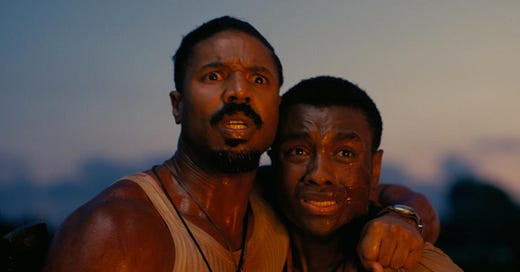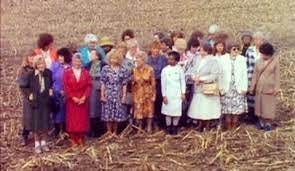New & now: Sinners
You don't need me to tell you how great this thing is, but I'm gonna anyway.
When I come across someone on social media claiming that horror movies are in a down period, I know immediately that their opinion on everything else can be safely ignored.
Now, we know at this point that when someone makes such a sweeping, dismissive claim, it’s because they don’t recognize the difference between “This isn’t for me” and “This is bad.” We all make that mistake sometimes, but not usually about an entire film genre. Nevertheless, I’ve encountered it on Reddit and in Facebook comments, people claiming with full confidence in themselves that horror these days has gotten “boring,” “lazy,” and “predictable.” Boring? I suppose, if you can’t get through five minutes of a movie without an ax going into someone’s face1. Lazy? Maybe if you consider even the freshest takes on a well-worn trope to be derivative. Predictable? Well, now, if you claim you saw the ending of The Substance coming, I might have to ask you if you also know tomorrow’s winning lottery numbers, because, brother, that is quite a talent.
ANYWAY, with the cynicism that comes from being both a woman and a near-lifetime horror fan, I suspect that the loudest denigrators of Ryan Coogler’s Sinners are going to be people who complain that any film featuring more than one (1) Black character is “woke.” But, amazingly, despite many of us having an almost pathological need to be contrarian, I’ve not seen too many naysayers yet, and that is because Sinners is a near-flawless motion picture.
I’ve seen a lot of horror movies that genuinely scared me, even beyond the usual classics. The most recent that comes to mind is 2022’s Talk to Me. I probably think about Us (2019) and Saint Maud (2020) at least once a week, though I wouldn’t describe them as scary so much as unsettling. Horror movies can be gross, they can be sad, they can make me laugh. But there aren’t many that I would describe as “exhilarating.” Sinners plays the viewer’s emotions like a fiddle, in a way that never feels cheap or manipulative.
Speaking of fiddles (if you’ll forgive my tortured attempt at a segue), music is at the center of the film. Obviously, music has been used to great effect in horror movies before, including The Exorcist, and, more recently, Hereditary, which had a score that was designed to sound evil, relying on discordant notes and reverb to set the viewer on edge from almost the beginning. In Sinners, music doesn’t just set the mood, it’s the core element of the plot. It sets various wheels in motion, both bringing the heroes together and putting them in the path of the villain(s).
It’s what motivates twin brothers Smoke and Stack (Michael B. Jordan) to return to their tiny Mississippi Delta town after pursuing their fortunes in Capone-era Chicago, with a load of stolen cash they’re eager to use as capital in opening a juke joint. The twins recruit their younger, sheltered cousin Sammie (Miles Caton), a prodigy on blues guitar (much to the displeasure of his preacher father), to be a featured act, and opening night is an overwhelming success.
Much has already been (and will continue to be) written about the breathtaking “piercing the veil” scene, when Sammie’s music is so powerful that it transcends time and place, bringing him together with generations of Black musicians both before and after him. I am not particularly good at writing about music, so instead I’ll direct you to Craig Jenkins’ excellent essay at Vulture, which does a far better job of breaking it down, and how something that in a less capable director’s hands would seem cheesy is instead a stunning, emotionally moving piece of art.
On the downside, such a powerful moment also draws the attention of Remmick (Jack O’Connell), an Irish vampire. While respecting the Vampiric Code of never entering a place when you haven’t been explicitly invited, Remmick and two KKK members he’s already recruited bide their time outside the juke joint, waiting for the unlucky folks who have had enough partying and want a little fresh air. When there are eventually more on his side than still in the club, he gets his own exhilarating musical moment, an Irish step-dance to the tune of “Rocky Road to Dublin.”
As film writer Michelle Kisner noted here, though both scenes touch upon cultural heritage and a celebration of storytelling through music, their differences are stark. Inside the juke joint, the experience is communal. Sammie’s music is the great equalizer, and everyone gets to participate. Outside, Remmick is at the center, singing and dancing to an Irish folk song, while mostly Black dancers jig and twirl behind him. It’s not their music, their experience they’re dancing about, it’s his, and as wild and wonderful as this moment is, it’s also deeply sinister.
It also makes more hollow Remmick’s seductive, cult leader-like pitch to Smoke, Stack, and the others that they should join forces with him, being that both Black and Irish people have long been victims of oppression. This is, of course, a myth white people have been perpetuating since the turn of the 20th century as an argument against the existence of white privilege. While it was true that Irish immigrants experienced discrimination in the U.S., and were often forced to take menial jobs in labor and housekeeping, it was not, in fact, just the same as slavery, because they were neither owned by their employers, nor in danger of arrest (or even death) if they tried to leave2. Nor did it make Irish immigrants any more accepting or empathetic to the struggle of Black Americans to earn their freedom. Remmick and the twins have a common enemy, but that doesn’t make them brothers under the skin.
Out of all the vampire movies writer-director Ryan Coogler found inspiration in for Sinners, the most obvious is, surprisingly, From Dusk Till Dawn, Robert Rodriguez’s entertaining but slight action-comedy-horror. which also features vampires laying waste to a seedy nightclub. It’s a remarkable feat to turn something that was mostly just an excuse for quippy dialogue and Tom Savini wielding a crotch gun into such a rich, emotional story.
Did I expect to get teary-eyed at the end of Sinners? Surely not, and yet, I did. Twice, actually (don’t miss the mid-credits sequence). Are you disappointed that vampire movies just aren’t sexy anymore, unless you count Bill Skarsgard hanging decayed dong in Nosferatu? Well, you’re in for a treat. With multiple romantic subplots, including Smoke passionately reuniting with his estranged wife (Wunmi Mosaku), the sexual chemistry is off the charts. While I don’t know if it’s outright scary, it’s definitely creepy, which, you know what, I’ll take it.
There seems to be some surprise that Sinners is doing as well as it is, and appealing to a wide demographic. Hollywood’s continued bafflement that original stories made for adults still occasionally find an audience is both amusing, and frustrating. Its success ought to mean that more filmmakers will get the opportunity to make something that isn’t Superforce Part 7: The Return of Blorko or a live-action version of Connect Four, but of course, no lessons will be learned. Thank goodness Sinners will hold up to repeated viewings.
Whenever I come across someone making this complaint, I like to point out that it’s nearly 45 minutes into The Exorcist before we get to the bed shaking scene and almost an hour into Alien before the chest-burster scene. In short, horror movies have not gotten longer and more boring in recent years, your attention span has just gotten shorter.






Great article Gena!